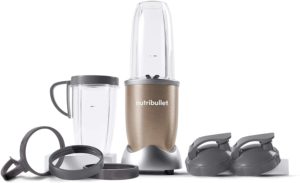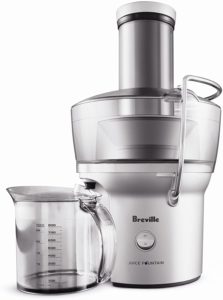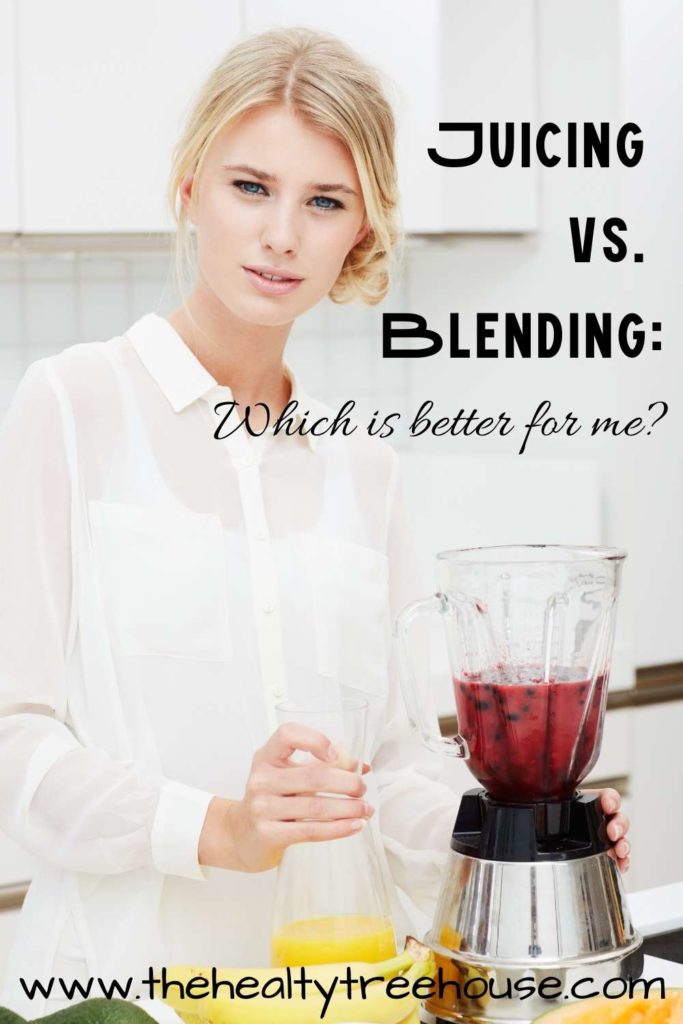
Getting all of your daily nutrients can be a struggle, especially if cooking is not your thing.
I should know; I struggled for years to figure out the perfect diet that left me feeling healthy and full.
Many different foods were making me sick and I wanted to figure out why and what I could do to change my diet.
One of the best decisions I’ve ever made for my health was purchasing a blender and a juicer.
A blender created my most beloved smoothies, soups, and salad dressings for healthful, flavorful, and wholesome meals.
My cold-pressed juicer allowed me to drink my nutrients in their most whole form.
Almost everyone can improve their diet in some way to aid in overall health, and for many, it all begins with purchasing a juicer and a blender.
Proponents for both claim that one is better than the other, so let’s explore their differences and weigh up their pros and cons.
This way, you’ll be able to decide which suits you best.
What Is Juicing?
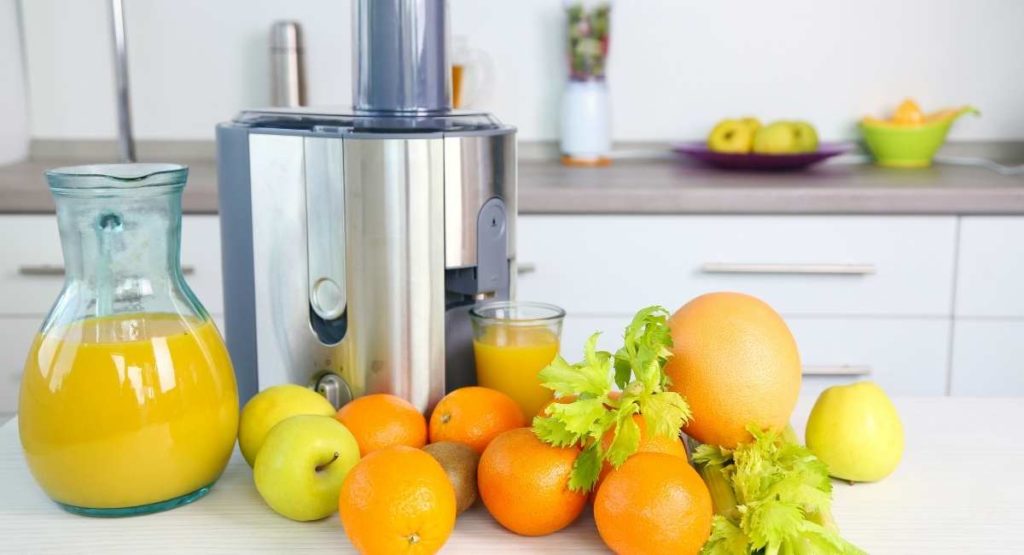
The process of juicing involves the extraction of the juice from whole fruits and vegetables.
All the solid matter is separated from the juice, like the seeds and pulp, and is then removed.
Juicers have allowed us to press tasty fruit juices that were harder to create before, such as apples or cranberries.
And if you’re a green juice advocate, juicers also work with kale, celery, spinach, wheatgrass, and cucumbers.
You can find out more about the best orange juicer and the best juicer for celery, which we extensively tested to find the best respective model.
Types of Juicers
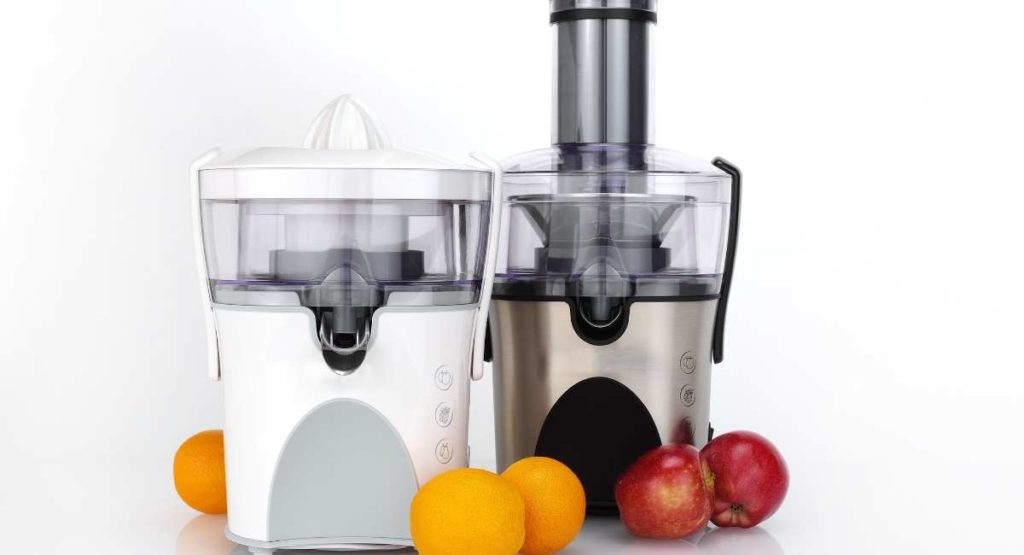
There are two kinds of juicers, used both personally and commercially: centrifugal and masticating.
Centrifugal Juicers
These use a high-speed spinning metal blade and centrifugal forces to press the fruit or vegetable against a strainer.
The juice moves through the strainer and ends up in a waiting container, from which you pour your drink.
Masticating Juicers
Also known as cold-press juicers, they use a brute crushing force via pressing, which squeezes all the juice out.
This usually takes a longer time compared to a centrifugal juicer, but it usually produces more juice.
They’re also usually larger and more expensive than centrifugal juicers.
Purpose of Juicing
Many of us don’t get enough essential nutrients, especially since many foods are processed and easily accessible.
This is where the benefits of juicing come in.
Supplementing Nutrients
To counter this, making juices is a good way to get a lot of nutrients in one concentrated drink without having to eat whole fruits.
Kids might prefer this, especially since kids love juice but don’t always love whole fruit.
As such, juicing is often used as a supplement to normal diets.
It’s also quite handy for those wanting to lose weight without giving up fruit and its health benefits.
If this is you, check out some juicing recipes for weight loss to find your perfect blend.
Detoxing
Additionally, juicers are also used for detoxes or a cleanse by avoiding solid foods for several days or weeks.
Instead, they only drink fresh juice.
There are claims for the effectiveness of juicing in clearing your body from toxins, but this is contested.
Another study has also shown juice diets’ harmful effects.
Even so, read all about what a juice cleanse is so you can determine if it’s the right thing for you.
Summary: Juicing is the process of extracting juice from a fruit or vegetable, discarding the solids, and supplying nutrients to your body. Masticating and centrifugal juicers are the two types of juicers available.
What Is Blending?
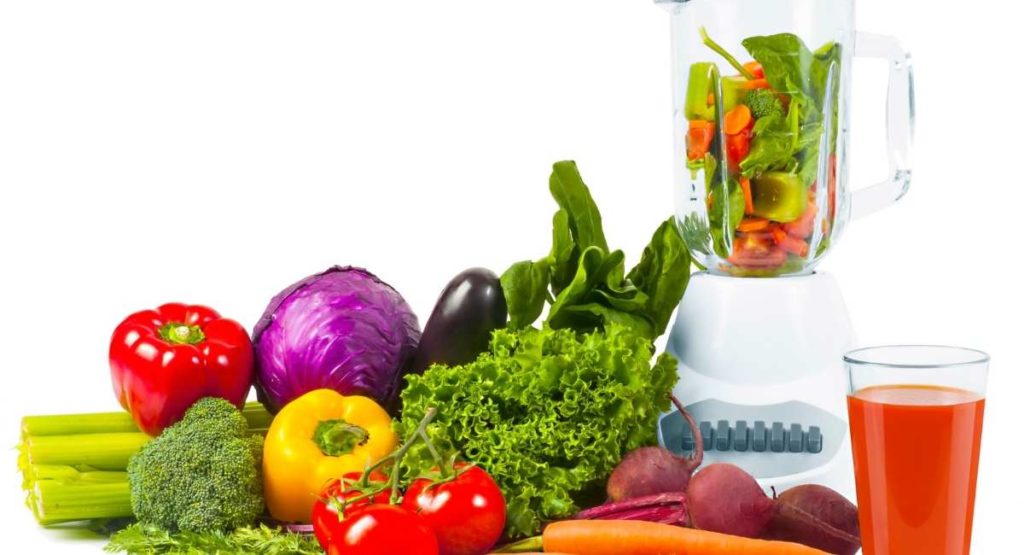
Unlike juicing, blending doesn’t leave anything out.
Everything is mixed, including all the pulp and fiber, which make up for the bulk of the fruit or vegetable.
You can use a blender to mix almost all kinds of food, not only smoothies.
They use high-speed metal blades, with some reaching 29,000 revolutions per minute.
A blender can sometimes come along with a food processor as part of a combo.
Types of Blenders
A blender comes in two types, which differ mainly in their serving capacity:
- Single-serving blenders
- Jug blenders
Single-Serving Blender
As the name suggests, this blender has a one-serving capacity.
They’re convenient to use while traveling, because of their smaller size and portability.
Jug Blender
A standard addition to a kitchen, these are used to prepare larger volumes of food, which is great if you want to meal prep in bulk.
You can find out more about the best Ninja blender after we tested every model they have to offer.
Also, read more on the best Nutribullet blender and the best Vitamix blender.
Purpose of Blending
In particular, blenders are a great way to make healthy smoothie recipes, especially if you or your kid refuses to eat greens.
Using one of the best blenders for green smoothies takes away the hassle of prepping greens and avoiding their strong flavors.
Additionally, the best blender for protein shakes is very handy for prepping a shake shortly after a workout.
This is because they’re able to blend nuts and powder with the fruits and vegetables—something juicers can’t do—so those protein shake recipes are much more achievable.
Blenders have ice crushing capabilities; something a juicer also cannot do.
This is amazing for hot summers when you’re done exercising and could use a cold and nutritious drink, which is where the best blender for frozen drinks excels.
Smoothies are delicious and have become fierce competitors of juices in terms of demand, and the juicer vs blender race is still on.
Summary: Blending is the process of breaking down produce with rotating metal blades. Blenders are commonly used for smoothies, salsas, and homemade ice cream.
What Do I Need to Make Juice and Smoothies?
So now that you have tons of juicing and smoothie recipes – what do you need to make them?
First you will need your machine; either a blender or a juicer based on your preferences.
Next you will need your favorite produce.
For example, if you love carrots, be sure to include them in your juice or smoothie.
Once you have your machine and your ingredients, you are set to start your health journey.
The Best Juicer and Blender Brands
Some of our favorite appliance brands are the makers of the best juicers and blenders, in our opinion.
Some of the best brands of juicers are:
- Amzchef
- Aobosi
- Aicok
- Picberm
- Breville
- Huntington Beach
- Cuisinart
Some of the best brands of blenders are:
- Vitamix
- Ninja
- Nutribullet
- Oster
- Homgeek

Pros and Cons of Juicing and Blending
When taking the below pros and cons into account, keep in mind that both juicing and blending can have a significant role in preparing food recipes, not just blended drinks.
For example, you can use the blender with baking ingredients, and you can use a juicer to prepare juices for a salad dressing.
However, you can also use a juicer when baking citrus desserts such as lemon bars or key lime pie, or a blender to emulsify a vinaigrette, so there is almost always more than one way to get there.
Here are 6 healthy salad dressing recipes, and you can use a blender or a juicer for the process!
That said, there’s still more to explore beyond the basic differences, so let’s dig a little deeper into some core areas:
- Nutrition
- Ingredient options
- Ease of use and cleaning
- Budget
Nutrition
Juicing Nutrition Pros
With juicing, you end up with a higher concentration of vitamins and minerals per ounce in your drink.
This is because they’re not as concentrated in the fruit or vegetable’s fiber and pulp, which are excluded and constitute the majority of the whole fruit or vegetable.
Additionally, studies have shown that consuming such mixed fruit-vegetable concentrated juices led to an increase in the levels of vitamins and antioxidants in your body as well as reduced stress markers.
On another note, it helps those who have trouble eating vegetables due to their taste obtain beneficial nutrients by having them as green juices.
This makes those yummy green juice recipes even more attractive!
Juicing Nutrition Cons
On the other hand, the lack of fiber and pulp in the juice can be problematic since you can usually end up drinking large amounts of juice to get a sense of fullness.
This can lead to high amounts of sugar consumption, especially with fruit juices.
Blending Nutrition Pros
With blending, you get everything inside the fruit—including its pulp, which contains fiber—blended in your drink.
Having an increased fiber intake helps to feel full and satiated.
Fiber is also massively important for a proper digestive process.
It can be categorized into two types, each of which has its role in digestion:
- Insoluble: Adds bulkiness and stimulates bowel movements, thus preventing constipation.
- Soluble: Slows down the digestive process, thereby managing sugar levels and staving off any hunger cravings.
Additionally, it was discovered that pulp doesn’t just contain fiber but also phytochemicals with antioxidant properties, so your body gets to benefit from a wider variety of antioxidants.
Does Blending Destroy Fiber?
No, blending doesn’t destroy fiber.
Although the blades break up the food, they’re not powerful enough to destroy fiber’s molecular structure.
So while you may feel that you’re ruining the health benefits of the food, no harm is done.
Blending Nutrition Cons
Consuming a blended drink or food is slower than one that’s juiced, purely due to the presence of the pulp and fiber, potentially resulting in consuming less nutrition.
Also, you can still consume a significant amount of sugar with blending; however, this is less so than with juicing due to the lower concentration of sugars—blended foods have an increased volume.
Ingredient Options
While many fruits and vegetables can be put in juicers or blenders, not everything works well for both.
Examples of fruits and vegetables that can be used in both are:
- Mangoes
- Spinach
- Oranges
- Pineapple
- Celery
Ingredients Best for Blending
Fruits such as dates, bananas, and avocados are well-suited because their juice is otherwise hard to extract from the complex carbohydrate and fat using a juicer.
Recipes such as this banana ice cream are perfect for any blender.
Soft-skinned produce like tomatoes work well in the blender, hence why the Pioneer Woman makes her signature salsa in the blender.
Solid and hard ingredients, like nuts, seeds, and powders, are best used in a blender rather than a juicer because they can otherwise damage them.
It’s also not possible to squeeze the juice out of such foods.
Additionally, other liquid or soft solid ingredients, like nut butter, essential oils, and kinds of milk are better used in a blender since they’re already pastes and liquids.
Greens are great in smoothies because they are usually undetectable, like this tasty kale smoothie, plus they add tons of nutrients.
Ingredients Best for Juicers
Fruits like oranges and lemons are much better off being juiced rather than blended, but can be blended if you have a blender powerful enough to do whole fruit blending.
Generally speaking, juicing is a better option when it comes to hard fruits where you wouldn’t eat the skin and hard vegetables, like cucumbers, broccoli, apples, carrots, since more juice can be extracted from them.
Watch this Juicing Vs. Blending Guide to learn more.
Use and Clean-Up
Using Juicers
Using a juicer involves more work since the ingredients need preparation beforehand.
On top of this, the machine can be a bit challenging to set up for those who are unfamiliar with it, which is why the best juicer for beginners is a go-to for many.
Cleaning Juicers
Juicers require regular cleaning to avoid the leftovers from drying up and staining the working parts.
This maintains the juicer’s quality, and it also prevents the risk of toxins due to fermentation.
However, juicers can be more challenging to clean than blenders.
They require more disassembly, and some of the parts, like the narrow chutes and the strainer, can be fiddly.
The best juicer that is easy to clean is a good option to avoid the hassle of others.
Using Blenders
Using a blender is pretty straightforward since they’re easy and quick to set up.
Also, the ingredients don’t have to be chopped up as much.
Blenders also usually work faster than juicers, especially masticating juicers.
Cleaning Blenders
Cleaning a blender is simple since they’re easy to disassemble with fewer parts, especially if you get a self-cleaning blender like this one.
Additionally, the pulps and leftovers can simply be rinsed off, and if you do need to give them a thorough clean, it’s no big deal.
Budget
It’s not fair to solely use price to weigh up the juicing vs blending options.
They do entirely different things, but that doesn’t mean your budget should go ignored.
Juicers
The price range of juicers is wide, with masticating juicers tending to be more expensive since they’re larger and usually have more intricate components.
If you want to be more mindful of your spending, take a look at the best affordable juicer.
Blenders
Blenders are generally quite affordable, and the best affordable blenders still pack a punch without compromising quality.
Summary: There are vast pros and cons to each blender and juicer. Weigh in your health and dietary needs when selecting the machine for you.
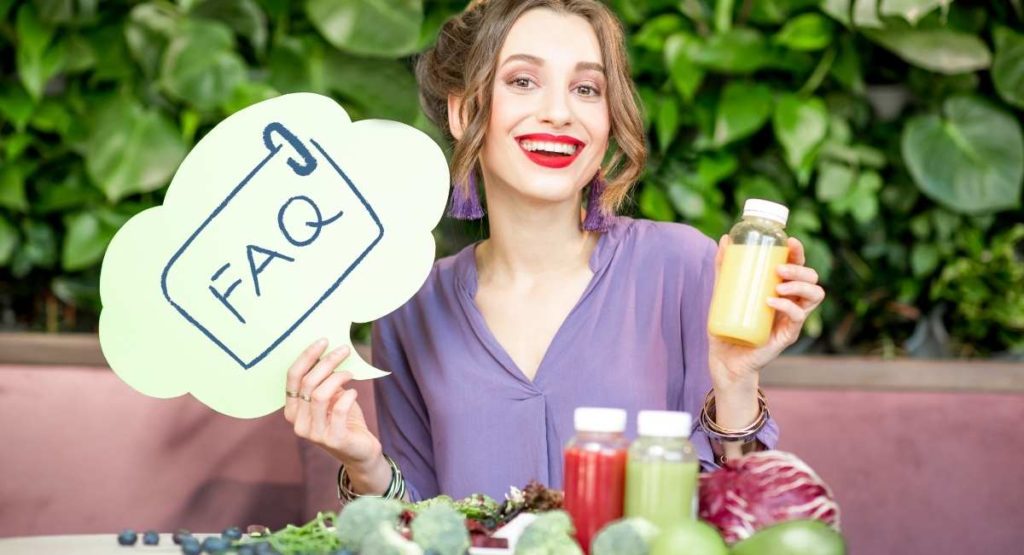
Frequently Asked Questions
Is It Better to Juice or Blend?
Whether it’s better to juice or blend depends on your health condition, health goals, and eating habits.
If you have a medical condition that mandates having a low-fiber diet, then it’s better to juice.
However, generally, blending is seen as better in most cases since it doesn’t exclude fiber nor produce spikes in sugar levels compared to juicing.
Can You Use a Blender Instead of a Juicer?
No, you can’t use a blender instead of a juicer.
Juicers are specialized in separating the pulp and removing it from the juice.
This is something that blenders don’t do, so you cannot use them as a replacement for juicers if your goal is to have vitamin and mineral concentrates with little to no pulp in them.
Is It Better to Juice or Blend Celery?
Whether it’s better to juice or blend celery depends on two things.
One is how much time you can dedicate to this since juicing is slower than blending.
The other is down to your taste preferences—juicing will retain the flavor more.
Either way, you’ll get the nutrients you’re looking for.
Additional Tools to Help with Juicing or Blending
Check out these handy accessories for whether you go with juicing or blending:
- Sharp knives: These are perfect for chopping up fruits and vegetables, so consider the Mercer Millennia 6-inch produce knife.
- Peelers: Helpful for peeling fruits and vegetables and much easier and faster compared to using regular knives. Check out the OXO Swivel peeler.
- Brushes: A great tool for the faster and more effective cleaning of juicers is Omega’s juicer cleaning brush.
Our Best Blender and Juicer Line-Ups
Juicers are machines that press the juice and nutrients out of fresh fruits and vegetables, while blenders chop and liquefy whole fruits, pulp included.
Not all blenders are created equal, especially when it comes to pleasing smoothie enthusiasts.
We tested a wide range of blenders to determine which one is the best smoothie maker – smoothie lovers unite!
Some blenders and juicers come as one machine; a blender and juicer combo.
These combo machines do wonders with your fruit and vegetables.
Are you someone who is sensitive to the noise of a blender?
Some models are built specifically for people sensitive to noise, so check out our best quiet blenders for sensitive ears.
Vitamix and Ninja are the two trusted brands in the blender world, but which ones reign supreme?
We researched and tested every Vitamix vs Ninja model we could find.
In addition to blending and juicing, check out our other recommended tools for meal prep that will make your life much easier.
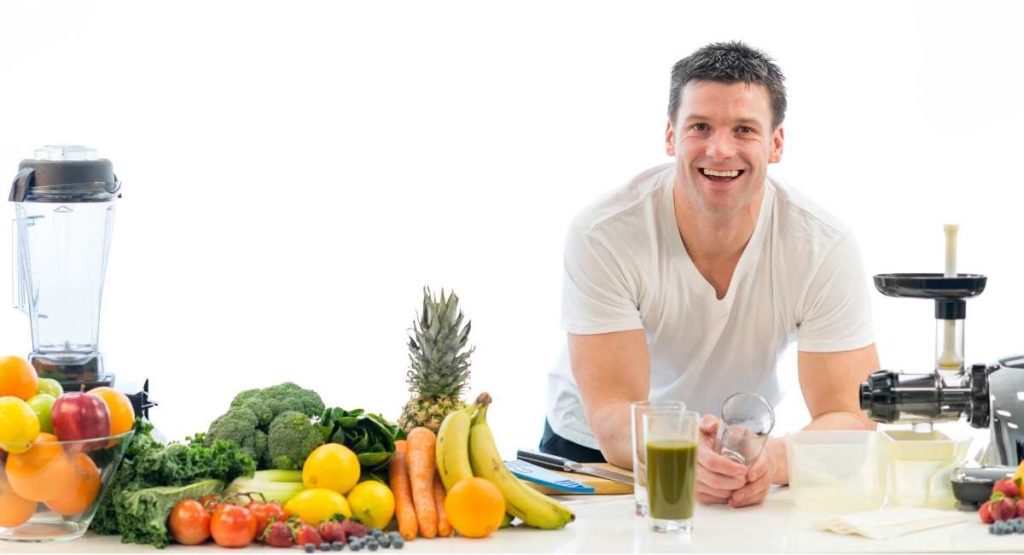
Summary
In short, there’s a common goal shared by juicers and blenders—providing delicious concoctions of fruit, vegetables, and many other food groups.
Juicers take all the pulp out and so provide higher concentrations of nutrients at lower volumes.
They’re more expensive, and they can be harder to use and clean, but they’re effective at juicing hard produce.
As for blenders, they don’t exclude the pulp but add it to the mix.
They’re usually cheaper and are easier to use and clean.
They’re a great choice for softer fruits as well as hard ingredients like nuts or seeds.
No matter which you chose, make sure it fits in with your exact lifestyle.


